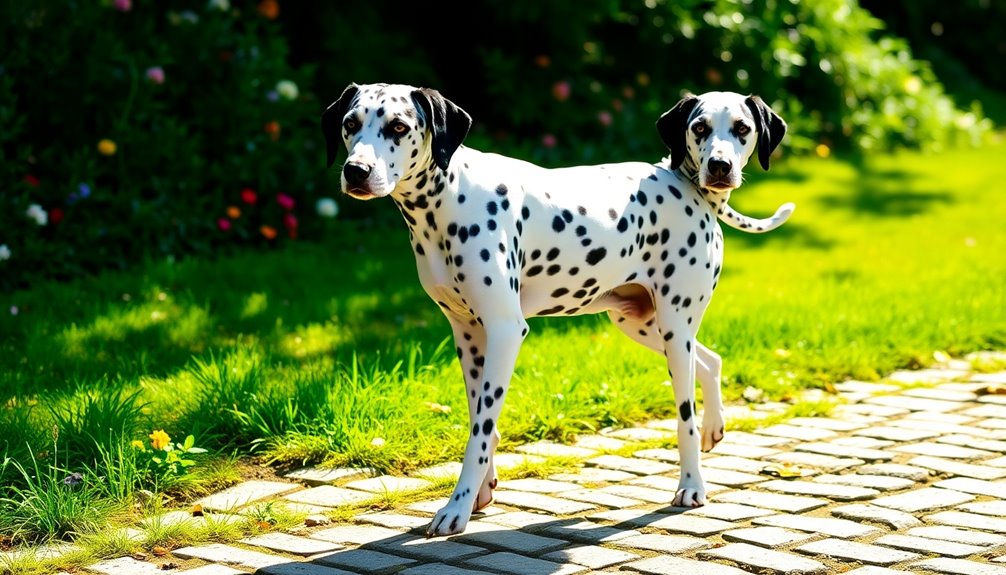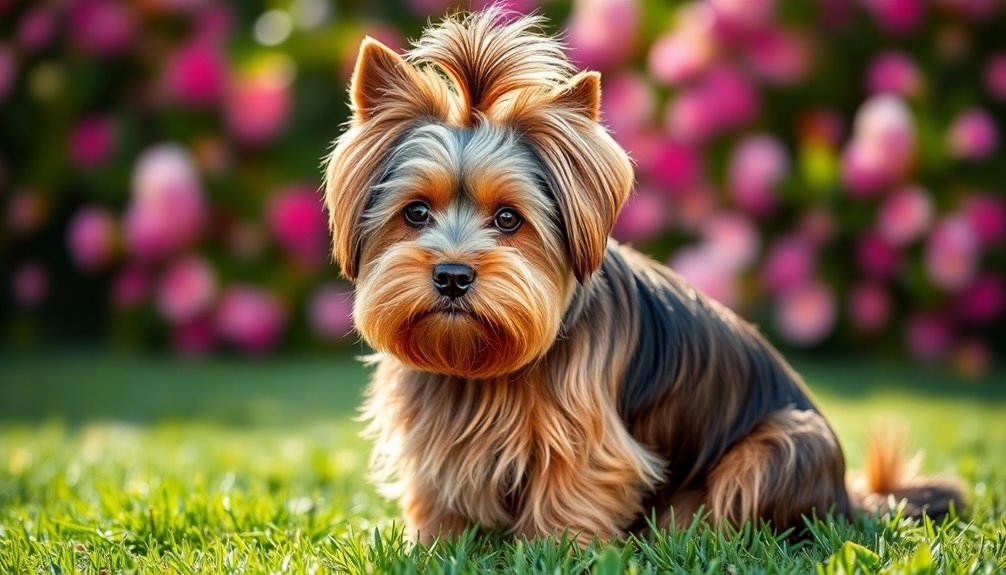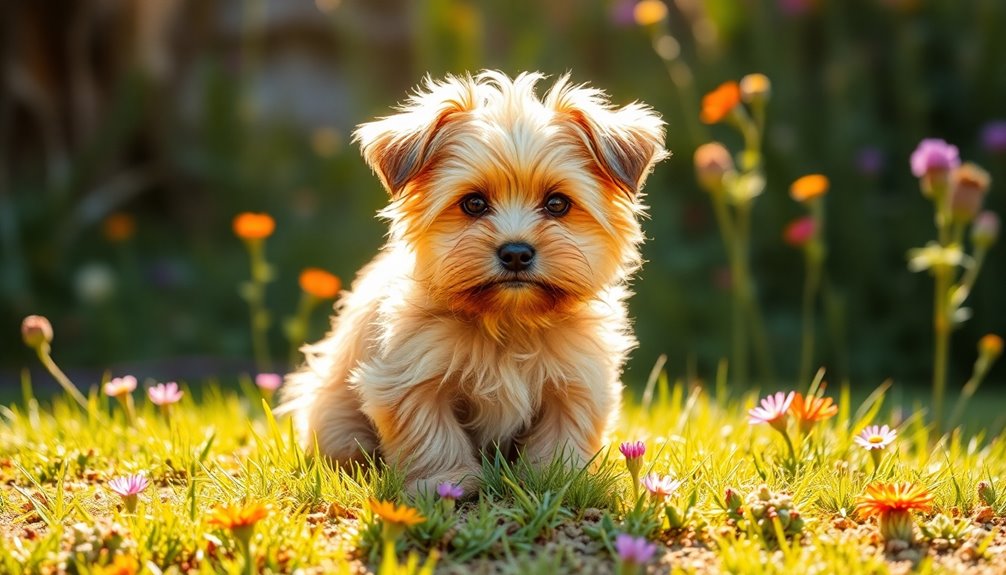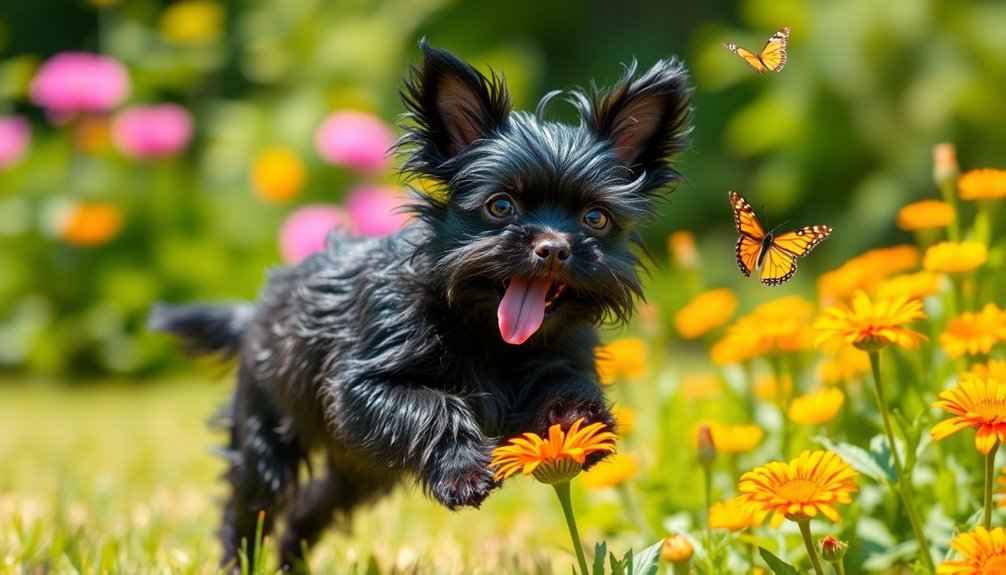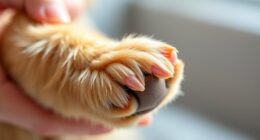Dalmatians are the spotty wonders you'll fall in love with! With their dazzling white coats adorned with unique black or liver spots, these dogs are as striking as they are energetic. They need at least two hours of exercise daily to keep their playful spirits high. Social, affectionate, and moderately easy to train, they thrive in active families. Remember, they require supervision around small kids. While they can face some health challenges, a balanced diet and regular vet check-ups can help. If you're intrigued by their history and quirks, there's so much more to discover about these fabulous dogs!
Key Takeaways
- Dalmatians are known for their distinctive white coat adorned with unique black or liver spots, making them visually striking.
- Originating from the eastern Mediterranean, Dalmatians have historical significance as carriage dogs, guardians, and companions.
- They possess a playful and energetic temperament, requiring at least two hours of daily exercise to stay healthy and happy.
- Dalmatians are moderately easy to train, benefiting from positive reinforcement and early socialization with other pets and children.
- Common health concerns include deafness and bladder stones, necessitating regular veterinary check-ups and a balanced diet.
Introduction
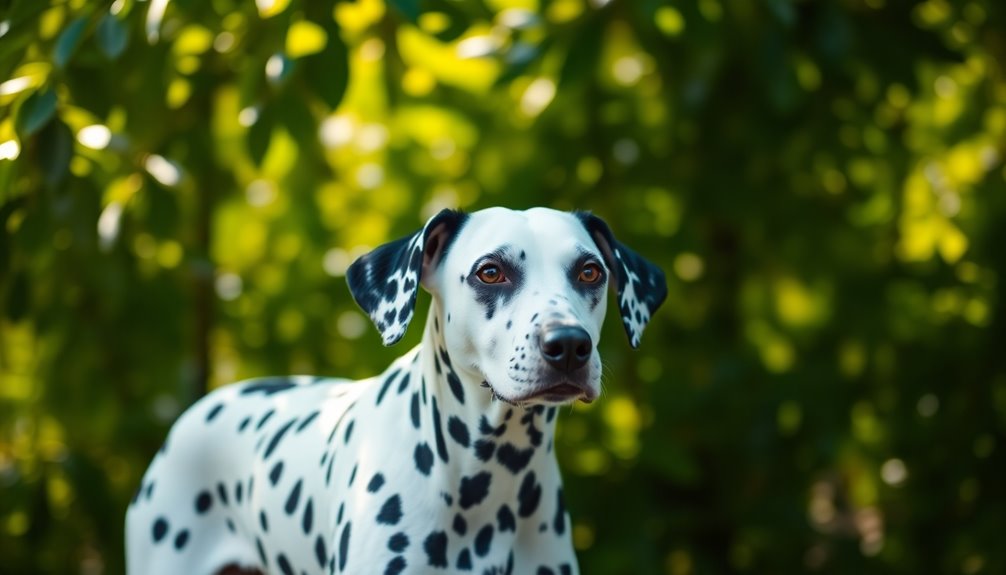
Dalmatians, often called the "spotty wonder," are a unique breed known for their striking appearance and lively personality. Standing between 19 to 24 inches tall and weighing between 45 to 65 pounds, they command attention with their short, white coat adorned with distinctive black or liver spots. Their moderate-sized ears sit high on their heads, rounded at the tips, adding to their charm.
These dogs are bursting with energy and require over 40 minutes of exercise each day. They thrive on playfulness, affection, and social interaction, making them a great companion for active families. However, while they can be medium-friendly with kids and other pets, their high energy levels may overwhelm very small children. Additionally, it's important to note that Dalmatians are born completely white, with their spots appearing around two weeks old.
Grooming is relatively low-maintenance, but be prepared for high shedding. Dalmatians do have specific health concerns, including a tendency toward urinary infections and deafness, so a balanced diet and regular check-ups are essential for their well-being.
If you're considering bringing a Dalmatian into your home, you'll need to ensure you can meet their exercise and social needs, especially if you don't have a spacious living environment.
History and Origin
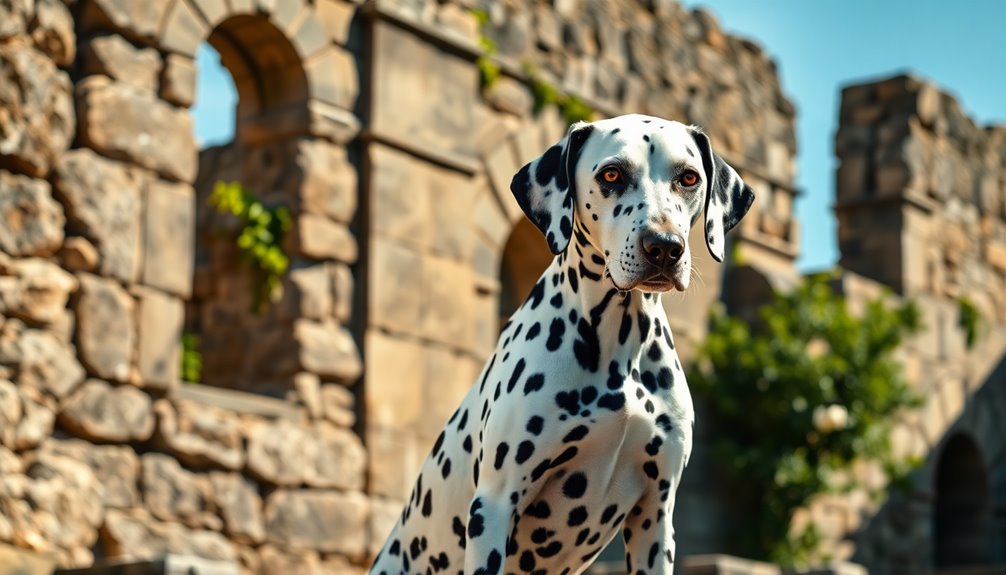
You might be surprised to learn that Dalmatians originated in the eastern Mediterranean, with their history stretching back centuries.
These dogs not only served as loyal companions but also became firehouse mascots and protectors, guarding both firefighters and their equipment. Their historical roles included being known as "The Carriage Dog(3)" due to their association with horse-drawn carriages.
Their unique blend of intelligence and loyalty has made them a beloved breed throughout the ages.
Where and when the breed originated
The Dalmatian breed has a rich history that traces back to the eastern Mediterranean, where its origins likely began. While the name suggests a connection to Dalmatia, this is often debated. It's possible that the breed's ancestry is much older and spans a broader region. You can find depictions of spotted dogs in ancient Egyptian tombs and Greek frescoes, indicating their historical significance.
The earliest written records of Dalmatians appear in Croatian church chronicles from 1719 and 1737, where they were referred to as *Canis Dalmaticus*. Thomas Pennant described them in 1771, and Thomas Bewick mentioned the breed in 1790. Artworks from the early 1600s also show these distinctive dogs in Croatia.
Throughout history, Dalmatians have played various roles, serving as dogs of war, guardians, and companions to horse-drawn carriages. They also excelled as bird dogs and retrievers, showcasing their versatility. Their high exercise needs make them ideal companions for active individuals or families.
While the breed's development primarily occurred in England, where standards were established in the late 19th century, its journey from the Mediterranean to your home illustrates its enduring charm and adaptability.
Firehouse Mascot and Protector
For over a century, Dalmatians have been celebrated as the iconic firehouse mascots, embodying a unique blend of loyalty and bravery. Originally, these dogs ran alongside horse-drawn fire carriages, calming the horses and preventing them from spooking. They served as vigilant guard dogs, protecting both the horses and fire equipment from theft and other animals. Their barking acted as an early warning system, alerting pedestrians that a fire wagon was approaching.
With the arrival of motorized fire trucks, the need for Dalmatians to protect horses diminished, but firehouses continued to keep them as mascots, maintaining tradition and camaraderie. Now, Dalmatians ride inside fire trucks, guarding equipment instead of running alongside. Their roles evolved to include catching pests in firehouses and comforting firefighters in times of stress. This bond with firefighters has only strengthened over the years, as Dalmatians became symbolic companions in the fire service.
Today, Dalmatians primarily symbolize firehouses and participate in educational programs about fire safety. They also engage in therapy and service roles, showcasing their adaptability and energy. Their iconic status, reinforced by media portrayals and initiatives like Sparky the Fire Dog, ensures that Dalmatians remain beloved symbols of loyalty and dedication within the fire service.
Physical Characteristics
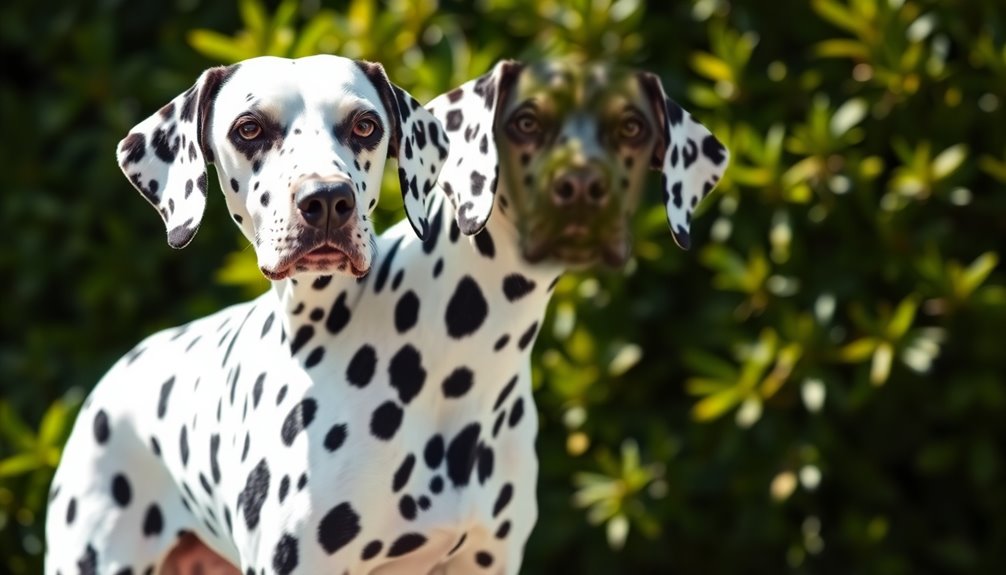
When you look at a Dalmatian, you can't help but notice its striking appearance. Standing between 19 to 23 inches tall and weighing 45 to 60 pounds, this breed boasts a muscular build that radiates strength and endurance. The iconic white coat, adorned with unique black or liver spots, develops rapidly, giving each dog its own eye-catching pattern. Interestingly, Dalmatians are born completely white, and their spot distribution varies as they grow, making each dog's coat truly one-of-a-kind.
Size, weight, and coat details
Dalmatians are medium-sized dogs known for their striking appearance and unique characteristics. Adult males typically stand about 22 to 24 inches at the shoulder, while females are slightly smaller, ranging from 20 to 22 inches. Their body length is roughly equal to their height at the withers, and they reach full growth around 15 months, although height growth typically ceases around 16 months.
In terms of weight, male Dalmatians generally weigh between 45 to 70 pounds, while females weigh between 40 to 55 pounds. At 3 months, puppies usually weigh around 20 to 30 pounds, and by 6 months, they generally weigh between 30 to 45 pounds. Final weights can vary by gender, falling anywhere from 35.3 to 70.5 pounds.
Regarding their coat, Dalmatians have a short, dense, fine, and close-fitting coat that's glossy and sleek. It's important to note that a correct Dalmatian coat shouldn't have patches, but rather distinct spots, and can either be black or liver.
Their body structure features a long, elegantly arched neck, a deep chest, and a tail that naturally extends from the topline, tapering to the tip.
Spots on White Coat
The iconic spots on a Dalmatian's white coat are one of the breed's most defining features, captivating dog lovers everywhere. These spots can either be black or liver, but you won't find both colors on the same dog. They're round and well-defined, evenly distributed across the body, with smaller spots adorning the head, legs, and tail.
You'll notice that these spots begin to develop around three to four weeks after birth, as pigmentation starts to manifest in the growing puppies. Each Dalmatian is born with pure white fur, making the appearance of spots a remarkable transformation.
Each Dalmatian boasts a unique spot pattern, much like snowflakes. The formation of these spots is influenced by several genes, including the S gene, which determines the extent of white spotting. The B and b alleles dictate whether your Dalmatian will have black or liver spots.
Interestingly, spots are distinct from patches, which are larger solid color masses, and they differ from roaning and ticking seen in other breeds.
As your Dalmatian matures, the spots may continue to develop until they're over a year old, showcasing the breed's genetic complexity and beauty. Each dog's pattern adds to the allure of this remarkable breed.
Temperament and Personality
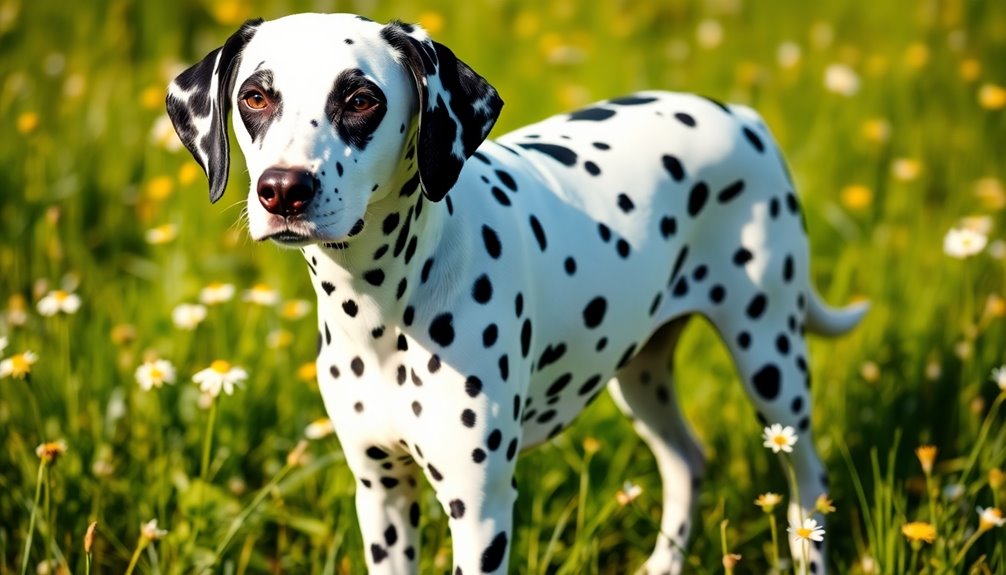
Dalmatians are known for their playful and spirited demeanor, making them a joy to have around. They fit well in active families, individuals, or even homes with other pets, as long as they're given the right attention and stimulation. You'll find that their affectionate nature shines through, strengthening the bonds with everyone in your household. Their high energy levels require daily exercise, which keeps them happy and well-adjusted.
Playful and Spirited Demeanor
Energetic exuberance defines the Dalmatian's playful and spirited demeanor, making them a delightful companion for active families. With their high energy level, these dogs require tons of physical and mental stimulation. If you lead a busy lifestyle filled with outdoor activities, a Dalmatian can match your pace, thriving on regular and vigorous exercise. Furthermore, they typically require approximately two hours of exercise each day to maintain their health and happiness.
However, if they don't get enough activity, they can become destructive, so keeping them engaged is essential.
Their intelligence and eagerness to learn contribute to their spirited nature. Dalmatians are moderately easy to train, but you'll need to be consistent and patient, as they can be easily distracted. Positive reinforcement works wonders, and their long memories aid in training sessions.
Affectionate and social, Dalmatians bond closely with their families and enjoy being involved in daily activities. While they can be reserved with strangers, their playful spirit shines through when they're with loved ones.
Expect some goofiness as they express their joy! Just remember, they might experience separation anxiety if left alone for too long, so plenty of companionship keeps their spirits high.
Suitability for families, individuals, or other pets
How well do Dalmatians fit into your family or lifestyle? If you're an active family, a Dalmatian could be a perfect match. They thrive on high energy and love being involved in every family activity, making them excellent companions for older children. However, keep in mind that their exuberance can lead to accidental knocks, so close supervision during playtime is essential.
For individuals, Dalmatians are best suited for those who lead an active lifestyle. They need plenty of exercise and attention, and they don't do well when left alone for extended periods. Their sociable nature makes them eager to engage with their owners and participate in various activities. Experience with dogs is a plus, as their stubbornness can pose challenges without proper training.
When it comes to other pets, early socialization is key. Dalmatians can get along with cats and other breeds, but they may chase small animals or show dominance towards same-sex dogs. If you have horses, you might find a natural affinity there. Overall, with the right approach to training and socialization, Dalmatians can bring joy to families, individuals, and harmony to multi-pet households.
Health and Lifespan
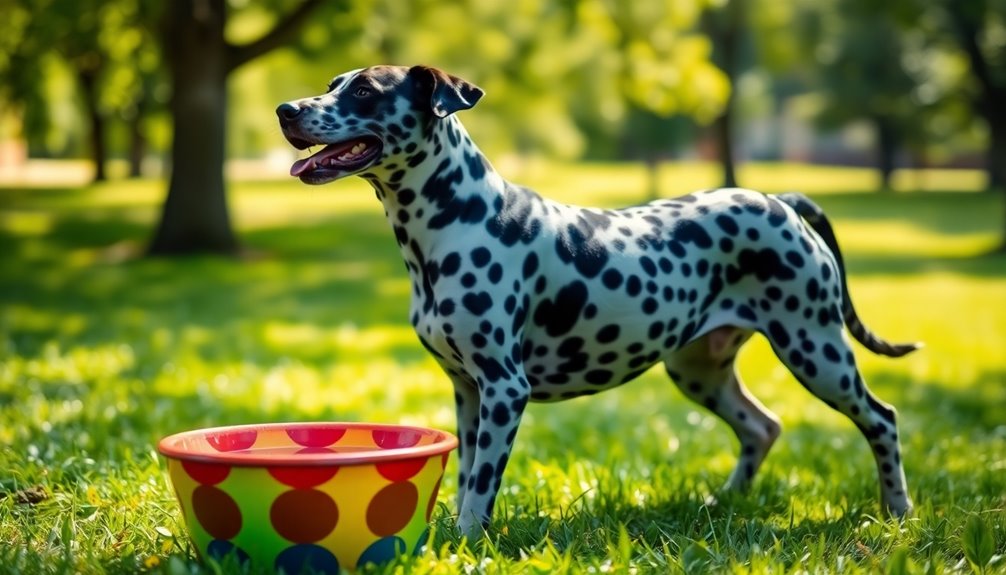
When it comes to your Dalmatian's health and lifespan, understanding common health issues is crucial. This breed typically lives around 11 to 13 years, but genetic predispositions can affect their well-being. Regular vet visits are essential for health monitoring and early detection of health issues, which can significantly influence their lifespan.
Typical lifespan of the breed
Dalmatians typically live between 11 and 13 years, making their lifespan average for medium to large-sized dogs. Some of these spotty companions can even reach their teens with proper care. Several factors influence their longevity, including genetics, nutrition, and lifestyle. To help your Dalmatian thrive, focus on providing a balanced diet and regular exercise. Additionally, incorporating nutrient-rich ingredients into their meals can further support their health.
During their lifespan, Dalmatians go through various life stages. Puppies and young adults, aged 0-18 months, require special attention as they mature. From 1 to 8 years, they transition into adulthood, where growth stabilizes. After 8 years, they enter their senior stage, which may bring changes in energy levels and potential health concerns. Adjusting exercise routines for senior Dalmatians is crucial to maintain their health.
Regular veterinary visits play a vital role in extending your dog's life. Routine check-ups can catch potential issues early, allowing for timely interventions. Additionally, annual physical exams are recommended to ensure early detection of any health issues that may arise.
Furthermore, responsible breeding practices can minimize the risk of genetic health problems. By being proactive in their care, you can help your Dalmatian live a long, healthy, and fulfilling life.
Common health concerns or genetic predispositions
While caring for your Dalmatian throughout its lifespan, it's important to be aware of common health concerns and genetic predispositions that can impact their well-being.
One significant issue is congenital sensorineural deafness, affecting up to 30% of Dalmatians. This condition is linked to the *MITF* gene, with specific genetic markers indicating a higher risk. If you're concerned, BAER testing can diagnose deafness early on.
Another common issue is high uric acid metabolism, which can lead to bladder and kidney stones. Dalmatians struggle to process uric acid due to a genetic mutation, making them more susceptible to urinary problems, particularly in middle-aged males. This predisposition to urinary stones can cause irritation and infections, necessitating regular monitoring.
Additionally, epilepsy is another hereditary concern, resulting in seizures. Although the genetic mechanism isn't fully understood, regular vet check-ups can help manage this condition.
Finally, be aware that Dalmatians can suffer from dilated cardiomyopathy (DCM), a serious heart condition. Yearly ECG screenings starting at age one are recommended for early detection.
Other issues, like atopy and various eye conditions, can also arise, so staying vigilant about your dog's health is crucial for their well-being.
Tips for maintaining health and wellness
To keep your Dalmatian healthy and thriving, focus on a balanced approach that includes proper diet, hydration, exercise, and regular veterinary care.
Start with a low-purine, high-quality kibble formulated for medium to large breeds. Incorporate lean protein supplements like chicken or turkey, and monitor fat intake to prevent weight gain. Feed your dog at scheduled times to control portions.
Hydration is crucial. Ensure fresh water is available in multiple locations and consider adding water to dry food or offering canned food with high water content. This helps maintain neutral urine, reducing the risk of urinary stones.
Dalmatians need at least two hours of daily exercise. Plan for two walks a day and incorporate playtime with activities like running and fetch. They thrive in active households, so keep their routine varied and engaging, while also providing mental stimulation through interactive toys and puzzles.
For general care, regular veterinary visits are essential for vaccinations and health checks.
Don't forget about grooming—weekly brushing, ear cleaning, dental care, and nail trimming are vital to prevent issues and keep your Dalmatian looking their best.
Prioritize these tips for a long, healthy life together!
Care Requirements
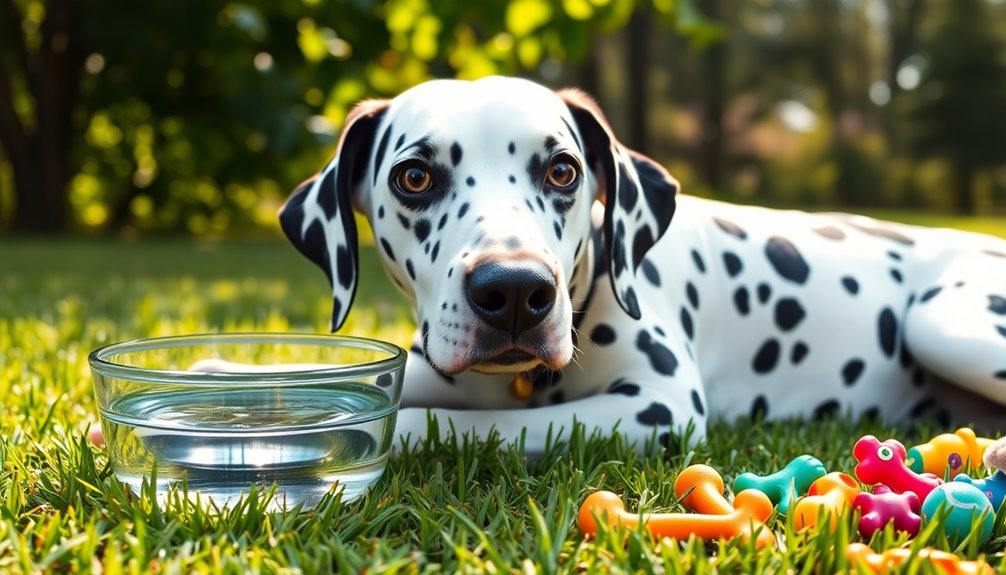
Caring for your Dalmatian involves understanding their exercise needs, grooming habits, and dietary requirements.
You'll need to ensure they get plenty of physical activity to match their high energy levels while also keeping their coat healthy with minimal brushing. To meet their exercise requirements, provide them with a minimum of 2 hours of daily activity. Regular outings for socialization can also enhance their adaptability and confidence.
Additionally, feeding them a balanced diet will help keep them in top shape for all those adventures together.
Minimal Brushing Required
Brushing your Dalmatian just once a week is all it takes to keep their coat looking great. Use a horsehair mitt or a rubber curry brush, and make long, slow strokes to effectively pick up dead and dying fur. This routine not only keeps their coat healthy but also helps reduce shedding and minimizes the amount of hair on your clothes and furniture.
Some Dalmatians may enjoy this grooming time, while others mightn't be as enthusiastic, so be patient and observant. Regular brushing can also help maintain coat brightness and cleanliness as desired by the owner.
Bathing your Dalmatian typically depends on their activity level and environment, with a general recommendation of every 6 weeks. Active dogs may require more frequent baths, but be cautious—over-bathing can lead to dry, flaky skin and irritation.
Nail trimming should occur once a month or as needed, while ear checks and cleaning should be part of your regular grooming routine to prevent infections.
To maintain your Dalmatian's overall health, a full grooming session every 6-8 weeks, including brushing, bathing, nail trimming, and ear care, is essential.
With these simple grooming needs, you can ensure your Dalmatian stays clean, happy, and healthy!
Exercise requirements and energy levels
Dalmatians thrive on consistent exercise and require at least an hour of activity daily, ideally split into two sessions. To keep your Dalmatian happy and healthy, aim for a minimum of two hours of exercise every day, incorporating both on-lead and off-lead time.
Don't forget to include playtime in a secure garden, as this will give them a chance to burn off energy in a safe environment. This breed is very energetic, so consider engaging in activities like jogging, cycling, or even competitive sports such as Flyball and agility. Regular recall training is also essential to ensure safety during these activities.
Dalmatians also enjoy mental stimulation—mix up their routine with brain games like hide and seek or exploring varied walking locations, like woodlands or beaches.
If you don't meet their exercise needs, you might find your Dalmatian exhibiting destructive behaviors like chewing or digging. A lack of physical activity can lead to health issues and even depression, so it's crucial to provide them with a lifestyle that includes regular, vigorous exercise. Many re-homed Dalmatians have exercise-related issues, highlighting the importance of sufficient exercise.
Feeding tips and diet recommendations
Feeding your Dalmatian a balanced diet is essential for their overall health and well-being. Start with high-quality animal-based proteins like chicken, turkey, lamb, duck, eggs, and fish. Avoid beef, as it's high in purines, which can cause health issues for Dalmatians. Aim for variety by including at least five different protein sources to ensure balanced nutrition.
Incorporate healthy fats for energy and small amounts of carbohydrates from vegetables, herbs, and berries for fiber and antioxidants. Keep hydration in mind by providing high-moisture foods and fresh water. Ensure that you choose low-purine proteins to help prevent urate stones and kidney problems.
Consider dietary supplements to enhance nutrition, focusing on natural, whole food options. Add organic full-fat cottage cheese or eggs for variety, and oils like coconut or salmon oil for extra benefits.
When it comes to feeding practices, offer 2% to 7% of your Dalmatian's ideal body weight daily, adjusting based on their size. Rotate their food regularly and include meaty bones and vegetables for diverse nutrients.
Lastly, consult your vet to tailor the feeding plan to your dog's life stage and activity level, ensuring they thrive.
Training and Socialization
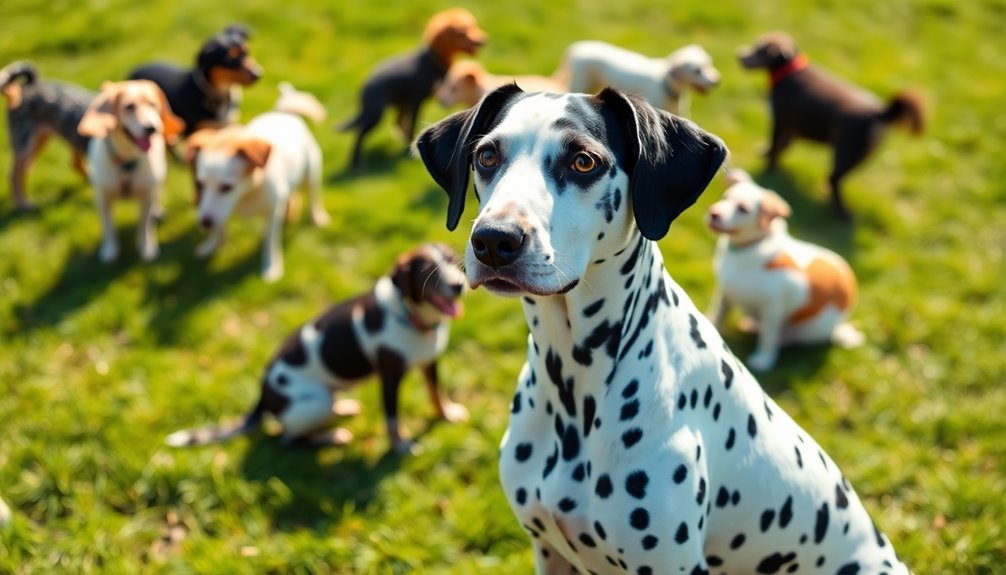
Training your Dalmatian can be an exciting journey, but it requires a balanced approach. You'll want to gradually expose them to new environments to build confidence while managing leash reactivity and impulse control. With a moderately independent training style, your Dalmatian will thrive with the right guidance and support. Regular exercise is crucial for preventing indoor accidents and helps to maintain their energy levels.
Moderately Independent Training Style
Success in training a Dalmatian hinges on understanding their moderately independent nature. These dogs can be stubborn, so using positive reinforcement techniques is crucial. Focus on rewarding correct behavior with treats, toys, and praise. Clicker training can be especially effective, signaling when your Dalmatian performs well, which encourages them to repeat that behavior. Additionally, incorporating local glider clubs can provide opportunities for structured training environments that mirror the consistency needed for successful Dalmatian training.
Consistency is key; all family members should apply the same training guidelines. Scheduled, structured sessions help maintain focus and yield better results. Break training into smaller steps to build your dog's confidence and keep them motivated. High-value rewards are particularly effective in the early stages. Additionally, incorporating vertical lists can help organize the training process and clarify expectations.
Dalmatians thrive on attention, so include attention work in your training to keep them engaged despite distractions. Patience is essential; avoid harsh corrections, as they respond poorly to negativity. Instead, encourage them with positive reinforcement to overcome their stubbornness.
Gradual Exposure to New Environments
Introducing your Dalmatian to new environments is essential for their overall development and confidence. Start early by exposing your puppy to various people, places, and sounds. This helps prevent fear-based reactions and anxiety later on.
Gradually introduce new environments, beginning with quieter areas like less crowded sections of parks. Use familiar toys or games to engage them and help ease their anxiety. Keep these initial sessions short, rewarding calm behavior with treats and praise. Ensuring that your Dalmatian receives ample outdoor time is crucial to their adaptability in new settings.
If your pup seems overwhelmed, retreat to quieter spots and try again later. Monitor your dog's reactions closely and adjust the pace based on their comfort level.
Bring along familiar objects, like their favorite toy, to create a sense of security. Gradually introduce different textures, surfaces, and recorded sounds to help them adapt.
Leash Reactivity and Impulse Control
Leash reactivity can be a challenging behavior to manage, but understanding its roots is the first step toward improvement. It often stems from feelings of restraint, frustration, or insecurity, leading your Dalmatian to lunge or act defensively. Identifying specific triggers is crucial in addressing this behavior effectively.
To help your dog, start with desensitization. Begin at a safe distance from the trigger where your Dalmatian remains calm, rewarding that calmness. Gradually decrease the distance over time, conditioning them to view the stimulus as non-threatening. This process is essential as leashed dogs may react defensively when unable to escape or approach.
Incorporate impulse control training into daily routines; teach your Dalmatian to wait patiently before meals or during walks.
Managing reactive episodes requires vigilance. Recognize signs of stress early and take action by creating U-turns to avoid triggers. Maintain calm body language and provide ample space to ease tension.
Using a loose leash can significantly reduce stress, allowing your dog to feel more secure. In some cases, consider consulting a professional for additional tools, such as medication, to help manage their reactivity.
With patience, positive reinforcement, and consistent training, you can significantly improve your Dalmatian's leash manners.
Ideal Living Environment
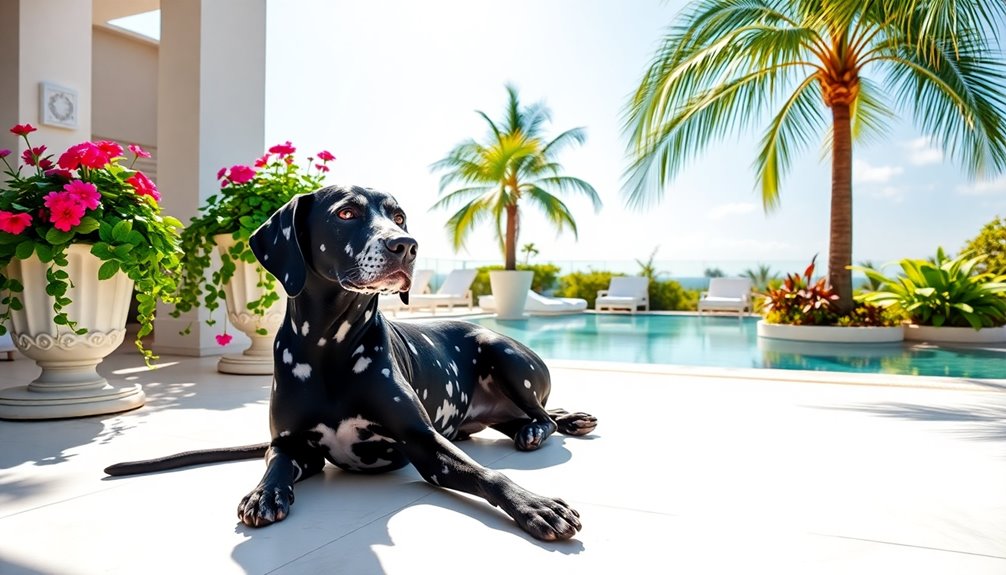
Dalmatians thrive in homes with ample space, allowing them to roam and exercise freely. While they can adapt to different living environments, keep in mind their heat intolerance during the summer months. Providing a cool, comfortable area is essential to keep your spotty friend happy and healthy. Regular vet check-ups are important due to their hip dysplasia risk, ensuring they remain active and healthy throughout their lives.
House With Ample Space
While a spacious home isn't a strict requirement, having ample space significantly enhances the living environment for your Dalmatian. These energetic dogs need at least two hours of exercise daily, which should include walks and opportunities to run in a secure area.
A large, securely fenced yard is ideal, allowing your Dalmatian to burn off energy and engage in natural instincts safely. Without sufficient exercise, you may find your dog resorting to destructive behaviors like chewing and digging.
Regular trips to the dog park can also provide vital social interaction, which is essential for their happiness. Your Dalmatian thrives on varied activities, including brain work, hide and seek, and exploring different environments like woodlands or beaches.
If you live in an apartment, it's crucial to create a designated area for your dog to rest and ensure access to outdoor spaces. However, spacious homes tend to offer the best environment, promoting both physical and mental stimulation.
Heat Intolerance in Summer
During summer, it's crucial to recognize that Dalmatians are particularly vulnerable to heat intolerance due to their short coats and high energy levels. They can dehydrate rapidly, especially after exercise or in hot climates.
Keep an eye out for symptoms like dry gums and heavy panting, which signal dehydration. If you notice excessive panting, a bright red tongue, or vomiting, act quickly, as heat stroke can damage vital organs.
To manage heat exposure, limit your Dalmatian's time outside during the hottest parts of the day. Create plenty of shaded areas for them to rest and consider using cooling mats or vests. Additionally, ensure that proper hydration is maintained through frequent water breaks, especially after playtime.
Avoid walking on hot surfaces, as this can lead to painful pad burns. Always provide access to fresh water to keep your dog hydrated.
Plan exercise during cooler times, like early mornings or late evenings, and skip intense activities when it's too hot.
Unique Spot Patterns Exist
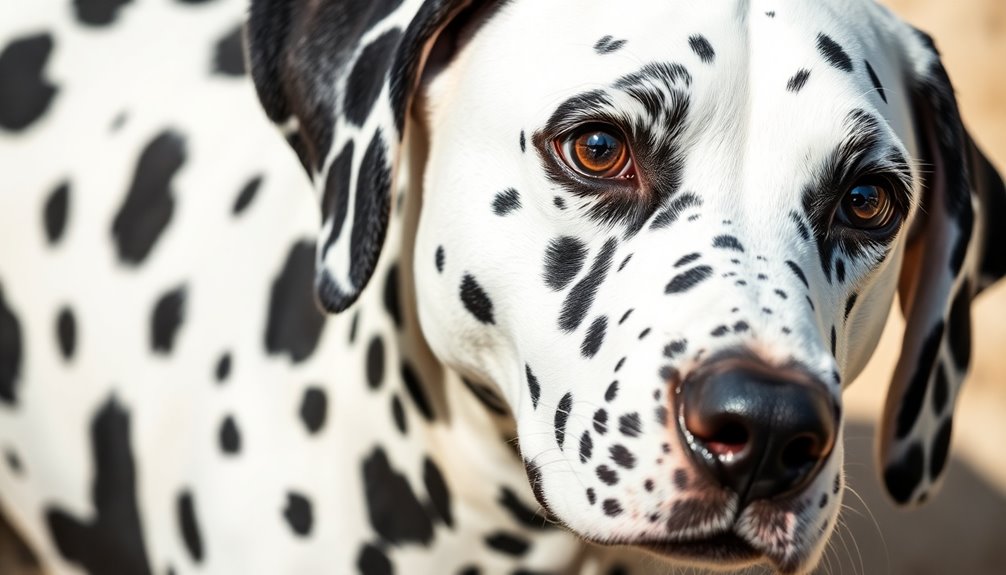
When you think of Dalmatians, the unique spot patterns often catch your eye, but there's more to their appearance than meets the eye. You might even recognize the distinctive ear shape variations that set them apart, or recall the iconic villain from "101 Dalmatians." These elements not only add to their charm but also highlight the breed's fascinating genetic diversity. Among these variations are dorsal stripes, which are more prevalent in liver-spotted Dalmatians and can add a distinctive flair to their overall appearance.
Distinctive Ear Shape Variations
Dalmatians are renowned not just for their striking appearance but also for their distinctive V-shaped ears, which play a crucial role in their ability to hear. These ears stand erect and pointed, much like those of Vizslas and Labrador Retrievers. The V-shape enhances sound collection and direction, making it easier for your Dalmatian to track noises in their environment. This trait is especially beneficial for breeds that require acute hearing to locate sounds accurately. Additionally, Dalmatians exhibit a variety of ear shapes, such as Sticky Uppy ears, which can further enhance their auditory capabilities.
However, there's a significant downside. Dalmatians are prone to deafness, impacting 15-30% of the breed. Deafness can affect one or both ears and typically develops in the first few weeks of life, often linked to the extreme piebald gene responsible for their unique coat.
If your Dalmatian has blue eyes, they're at an even higher risk, as this trait correlates with increased chances of deafness.
To reduce the incidence of deafness, it's crucial to breed Dalmatians with normal hearing in both ears. By being aware of these genetic factors, you can help ensure a healthier future for this remarkable breed while appreciating their iconic ear shape.
101 Dalmatians' Iconic Villain
The unique spot patterns of a Dalmatian are as captivating as their storied history. These spots result from intricate genetic interactions, primarily involving the white spotting locus (S gene), the Roaning allele (R), and the Flecking allele (f). Interestingly, spots start appearing just 3-4 weeks after birth on an initially plain white coat. You'll notice that Dalmatians sport either black or liver spots, but never both, and their sizes can vary from a dime to a half-dollar. Each Dalmatian's spot pattern is entirely unique, a testament to genetic variability. Ideally, their spots don't intermingle, maintaining distinct edges according to AKC standards. However, if you see larger masses with uneven edges or scattered white hairs, those aren't classified as patches but rather as anomalies in the expected pattern.
Historically, Dalmatians have been depicted in art since ancient Egypt, showcasing their distinctive spots. The breed standard explicitly prohibits patches, ensuring that the iconic spotted appearance remains a hallmark of Dalmatians. Interestingly, the genetic lineage of Dalmatians is unclear, but their closest relatives include sporting dogs like Weimaraners. As you admire their unique patterns, remember that each Dalmatian tells a story through its spots, making them truly one-of-a-kind companions.
Active Lifestyle Compatibility
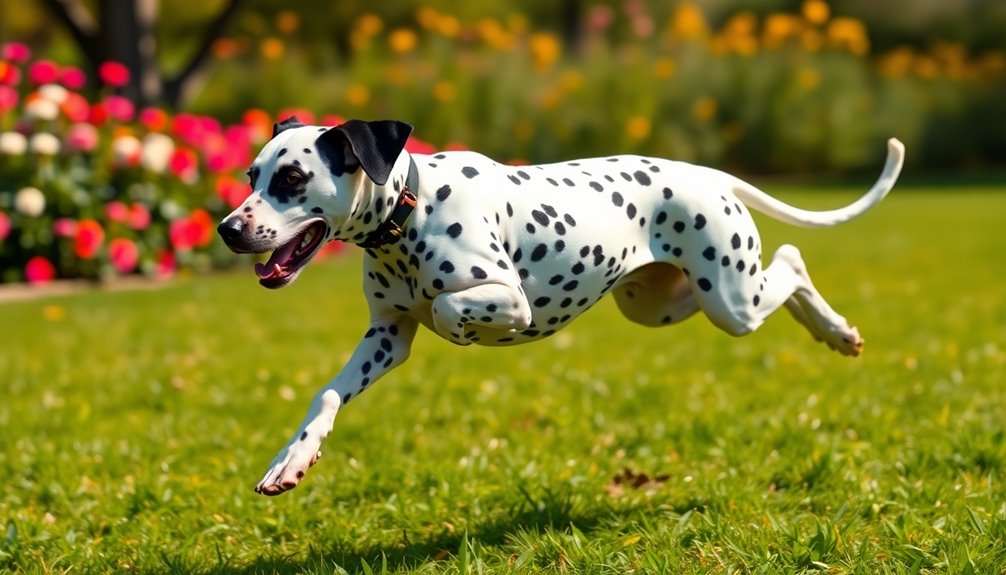
If you lead an active lifestyle, a Dalmatian could be the perfect companion for you. These energetic dogs require at least two hours of exercise each day, making them well-suited for those who enjoy outdoor activities like jogging or cycling. With their high energy levels and playful nature, Dalmatians thrive in environments where they can stay engaged and active. Additionally, the use of bullet point lists can help you organize and present information about Dalmatians effectively, especially if you're considering their care and exercise needs. It's important to note that Dalmatians also benefit from consistent training to channel their energy positively and ensure they remain well-behaved companions.
Energetic Companions for Active Owners
Often sought after by active families, Dalmatians thrive in environments where they can expend their abundant energy. If you're an outdoor enthusiast who enjoys walking, running, or hiking, a Dalmatian will make a perfect companion.
These dogs require plenty of interaction and exercise, so be prepared to dedicate time to their needs. They're not well-suited for apartment living unless you're committed to long daily walks or runs. Regular veterinary check-ups are also essential to ensure your dog's health and longevity.
Dalmatians are social dogs that benefit from proper socialization from a young age. Regular training keeps their minds sharp and helps prevent behavioral issues. Engaging them in activities like agility, tracking, or scent work won't only provide mental stimulation but also strengthen your bond.
They generally get along well with children, though their high energy might be too much for very small kids.
To keep your Dalmatian happy and healthy, ensure they're never left alone for too long. They thrive on human companionship and can become destructive if they feel isolated.
If you're ready for an active lifestyle, a Dalmatian can be the energetic companion you've been searching for!
High Exercise Needs Required
Dalmatians have high exercise needs that demand your attention and commitment. To keep your adult Dalmatian happy and healthy, aim for at least one hour of exercise daily, ideally two. This should include a mix of walking and running, with some time off-lead for free running. Two walks a day, especially in secure areas, are highly recommended.
Incorporate a variety of activities like jogging, cycling, and even water play to keep things exciting. Dalmatians excel in sports like Flyball and agility, utilizing their intelligence and athleticism. Exploring different terrains such as woodlands and beaches helps prevent boredom and supports their mental well-being. Access to a large backyard can significantly enhance your ability to meet their exercise requirements.
Mental stimulation is just as crucial. Engage your Dalmatian with interactive games, hide and seek, or training sessions to keep their minds active. Socialization and varied walking paths can mold your pup into a well-adjusted adult dog.
Neglecting their exercise needs can lead to destructive behaviors, including chewing or digging. Remember, your Dalmatian thrives on both physical and mental challenges, so be prepared to invest time and energy into maintaining their active lifestyle.
Frequently Asked Questions
Do Dalmatians Shed a Lot of Fur?
Yes, Dalmatians do shed a lot of fur. They've a dual coat that causes continuous shedding throughout the year.
You'll notice heavier shedding during seasonal changes, especially in spring and fall.
Regular grooming, like weekly brushing, can help manage the loose fur and maintain their coat.
Keep an eye on their skin health, as allergies or health issues can lead to increased shedding.
With proper care, you can minimize the mess.
Are Dalmatians Good With Children?
Dalmatians can be great companions for kids, but you need to ensure they get proper training and socialization.
Their energetic nature makes them fun playmates for active children, though they might be too much for very young ones.
Early exposure to children is crucial to avoid any defensive behavior.
Always supervise interactions to keep everyone safe and happy.
With the right approach, your Dalmatian can thrive in a family environment.
What Is the Average Weight of a Dalmatian?
The average weight of a Dalmatian varies by gender.
Adult males typically weigh between 45 to 70 pounds, while females range from 40 to 55 pounds.
As a puppy, you'll see them grow quickly; at 3 months, they weigh around 20 to 30 pounds, and by 6 months, they'll be between 30 to 45 pounds.
Keeping an eye on their weight during these growth phases is essential for their overall health.
Can Dalmatians Live in Apartments?
Yes, you can have a Dalmatian in an apartment, but it requires careful planning.
You'll need to provide plenty of daily exercise—at least an hour split into sessions.
Make sure to create an engaging environment with interactive toys and playtime. A large, securely fenced area nearby is ideal for outdoor activities.
You should also focus on socialization to prevent behavioral issues, ensuring your Dalmatian stays happy and well-adjusted in an apartment setting.
How Much Exercise Do Dalmatians Need Daily?
Dalmatians need at least 1 to 2 hours of exercise daily to stay healthy and happy.
You can split this into one or two sessions, mixing physical activity with mental stimulation. Activities like brisk walks, jogging, and fetch are great options.
Don't forget to include some off-lead time for free running.
If you skip exercise, your Dalmatian might develop destructive behaviors, so keep them active, rain or shine!
Conclusion
In conclusion, the Dalmatian's unique charm, from its striking spots to its lively personality, makes it a fantastic companion for active families. With proper training, socialization, and a suitable living environment, you can enjoy a fulfilling life together. Remember to prioritize their health and keep them engaged in activities that match their energetic nature. If you're ready for a loyal, playful friend, the Dalmatian might just be the perfect addition to your home!

